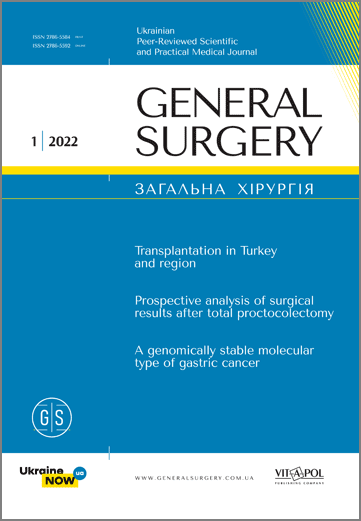A genomically stable molecular type of gastric cancer as a predictor of peritoneal relapse after radical surgical treatment
DOI:
https://doi.org/10.30978/GS-2022-1-28Keywords:
gastric cancer, peritoneal relapse, genomically stable molecular type, E‑cadherin, peritoneal metastases, intraperitoneal chemotherapyAbstract
Peritoneal metastases are commonly associated with gastric cancer (GC) recurrence after radical treatment. Thus, patients at a high risk of peritoneal relapse require adjuvant intraperitoneal chemotherapy during the initial treatment. Along with clinical and morphological predictors of peritoneal relapse, another approach in surgical oncology is proving to be promising today. It refers to the prediction of the risk of developing metachronous peritoneal metastases in various molecular types of GC.
Objective — to study the risk of peritoneal relapse in patients with the genomically stable type of GC in comparison to its other molecular types.
Materials and methods. 37 patients with GC were enrolled into the study and evaluated after the radical treatment. 19 (51.4 %) patients formed a subgroup with peritoneal relapse and 18 patients (48.6 %) were included into a subgroup without metachronous carcinomatosis in the long term. All patients underwent immunohistochemical study for the E‑cadherin (CDH1 gene) expression in a gastric tumor. The genomically stable molecular type was identified on the basis of the aberrant E‑cadherin (CDH1‑mutated) tumor phenotype detection.
Results. There was a statistically significant difference (p = 0.022, χ2 = 5.22) in the degree of aberrant E‑cadherin expression in subgroups of patients with and without peritoneal relapse — 68.4 and 33.3 %, respectively. Hence, it was noted that the genomically stable molecular type had a significant influence on the risk of peritoneal recurrence: the 2‑year peritoneal relapse‑free survival of GC patients with E‑cadherin of aberrant type was 31.6 %, and in GC patients with wild‑type E‑cadherin expression — 71.4 % (p = 0.022). The 2‑year overall survival of GC patients with aberrant type E‑cadherin expression was 36.8 %, whereas in GC patients with E‑cadherin of the wild type — 77.8 % (p = 0.003).
Conclusions. The study found that the genomically stable molecular type of GC may serve as a predictive factor associated with an increased probability of peritoneal relapse, as well as a prognostic factor due to its negative impact on patient prognosis. The genomically stable molecular type of GC may be used as a tool for forming a cohort of patients with indications for adjuvant intraperitoneal therapy.
References
Barber M, Murrell A, Ito Y, et al. Mechanisms and sequelae of E-cadherin silencing in hereditary diffuse gastric cancer. J Pathol. 2008;216(3):295-306. doi: 10.1002/path.2426.
Cancer Genome Atlas Research Network. Comprehensive molecular characterization of gastric adenocarcinoma. Nature. 2014;513(7517):202-9. doi: 10.1038/nature13480.
Chen S, Cai MY, Chen YB, Li YF, Feng XY, Zhou ZW. Serosa-penetration in human T4aN0M0 gastric carcinoma correlates with worse prognosis after D2 gastrectomy. Chin Med J (Engl). 2012;25(6):1158-62. doi: 10.3760/cma.j.issn.0366-6999.2012.06.034
Chen Y, Zhou Q, Wang H, et al. Predicting peritoneal dissemination of gastric cancer in the era of precision medicine: molecular characterization and biomarkers. Cancers. 2020;12:2236. doi:10.3390/cancers12082236
Cho SY, Park JW, Liu Y, et al. Sporadic early-onset diffuse gastric cancers have high frequency of somatic CDH1 alterations, but low frequency of somatic RHOA mutations compared with late-onset cancers. Gastroenterology. 2017;153:536-49. doi.org/10.1053/j.gastro.2017.05.012.
Coccolini F, Catena F, Glehen O, et al. Effect of intraperitoneal chemotherapy and peritoneal lavage in positive peritoneal cytology in gastric cancer. Systematic review and meta-analysis. Eur J Surg Oncol. 2016;42(9):1261-7. doi: 10.1016/j.ejso.2016.03.035.
Corso G, Carvalho J, Marrelli D, et al. Somatic mutations and deletions of the E-cadherin gene predict poor survival of patients with gastric cancer. J Clin Oncol. 2013;31(7):868-75. doi: 10.1200/JCO.2012.44.4612.
Götze TO, Piso P, Lorenzen S, et al. Preventive HIPEC in combination with perioperative FLOT versus FLOT alone for resectable diffuse type gastric and gastroesophageal junction type II/III adenocarcinoma — the phase III «PREVENT»- (FLOT9) trial of the AIO /CAOGI /ACO. BMC Cancer. 2021;21:1158. doi.org/10.1186/s12885-021-08872-8.
Misawa K, Mochizuki Y, Sakai M, Teramoto H, Morimoto D, Nakayama H, Tanaka N, Matsui T, Ito Y, Ito S, Tanaka K, Uemura K, Morita S, Kodera Y; Chubu Clinical Oncology Group. Randomized clinical trial of extensive intraoperative peritoneal lavage versus standard treatment for resectable advanced gastric cancer (CCOG 1102 trial). Br J Surg. 2019;106(12):1602-10. doi: 10.1002/bjs.11303.
Roviello F, Marrelli D, de Manzoni G, et al. Prospective study of peritoneal recurrence after curative surgery for gastric cancer. Br J Surg. 2003 Sep;90(9):1113-9. doi: 10.1002/bjs.4164.
Sugarbaker PH, Van der Speeten K. Adjuvant HIPEC for gastric cancer. J Gastrointest Oncol. 2021;12(Suppl 1):S18-S19. doi: 10.21037/jgo-2020-08
Sung H, Ferlay J, Siegel RL, Laversanne M, Soerjomataram I, Jemal A, Bray F. Global Cancer Statistics 2020: GLOBOCAN Estimates of Incidence and Mortality Worldwide for 36 Cancers in 185 Countries. A Cancer Journal for Clinicians. 2021;71(3):209-49.
Takebayashi K, Murata S, Yamamoto H, et al. Surgery-induced peritoneal cancer cells in patients who have undergone curative gastrectomy for gastric cancer. Ann Surg Oncol. 2014;21(6):1991-7. doi: 10.1245/s10434-014-3525-9.
Takeno A, Takemasa I, Seno S, et al. Gene expression profile prospectively predicts peritoneal relapse after curative surgery of gastric cancer. Ann Surg Oncol. 2010;17:1033-42. doi: 10.1245/s10434-009-0854-1.
Yoo CH, Noh SH, Shin DW, Choi SH, Min JS. Recurrence following curative resection for gastric carcinoma. Br J Surg. 2000;87(2):236-42. DOI: 10.1046/j.1365-2168.2000.01360.x.






